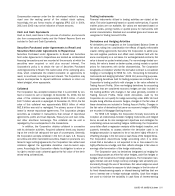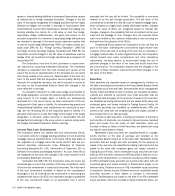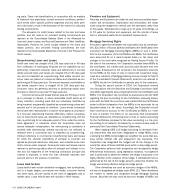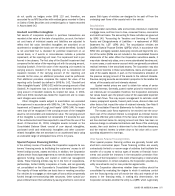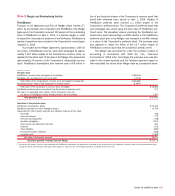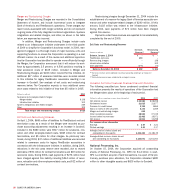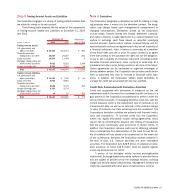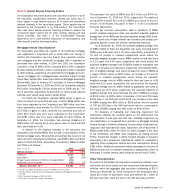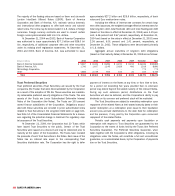Bank of America 2004 Annual Report Download - page 114
Download and view the complete annual report
Please find page 114 of the 2004 Bank of America annual report below. You can navigate through the pages in the report by either clicking on the pages listed below, or by using the keyword search tool below to find specific information within the annual report.
BANK OF AMERICA 2004 113
The average fair value of Derivative Assets for 2004 and 2003 was
$28.0 billion and $27.8 billion, respectively. The average fair value
of Derivative Liabilities for 2004 and 2003 was $15.7 billion and
$15.9 billion, respectively. Included in the average fair value of
Derivative Assets and Derivative Liabilities in 2004 was $1.5 billion
and $920 million, respectively, from the addition of derivatives
acquired from FleetBoston.
ALM Process
Interest rate contracts and foreign exchange contracts are utilized in
the Corporation’s ALM process. The Corporation maintains an overall
interest rate risk management strategy that incorporates the use of
interest rate contracts to minimize significant unplanned fluctuations
in earnings that are caused by interest rate volatility. The
Corporation’s goal is to manage interest rate sensitivity so that move-
ments in interest rates do not significantly adversely affect Net
Interest Income. As a result of interest rate fluctuations, hedged
fixed-rate assets and liabilities appreciate or depreciate in market
value. Gains or losses on the derivative instruments that are linked
to the hedged fixed-rate assets and liabilities are expected to sub-
stantially offset this unrealized appreciation or depreciation. Interest
Income and Interest Expense on hedged variable-rate assets and
liabilities, respectively, increase or decrease as a result of interest
rate fluctuations. Gains and losses on the derivative instruments that
are linked to these hedged assets and liabilities are expected to sub-
stantially offset this variability in earnings.
Interest rate contracts, which are generally non-leveraged
generic interest rate and basis swaps, options and futures, allow the
Corporation to manage its interest rate risk position. Non-leveraged
generic interest rate swaps involve the exchange of fixed-rate and
variable-rate interest payments based on the contractual underlying
notional amount. Basis swaps involve the exchange of interest pay-
ments based on the contractual underlying notional amounts, where
both the pay rate and the receive rate are floating rates based on dif-
ferent indices. Option products primarily consist of caps, floors, swap-
tions and options on index futures contracts. Futures contracts used
for the ALM process are primarily index futures providing for cash pay-
ments based upon the movements of an underlying rate index.
The Corporation uses foreign currency contracts to manage the
foreign exchange risk associated with certain foreign currency-denom-
inated assets and liabilities, as well as the Corporation’s equity
investments in foreign subsidiaries. Foreign exchange contracts,
which include spot, futures and forward contracts, represent agree-
ments to exchange the currency of one country for the currency of
another country at an agreed-upon price on an agreed-upon settle-
ment date. Foreign exchange option contracts are similar to interest
rate option contracts except that they are based on currencies rather
than interest rates. Exposure to loss on these contracts will increase
or decrease over their respective lives as currency exchange and
interest rates fluctuate.
Fair Value and Cash Flow Hedges
The Corporation uses various types of interest rate and foreign cur-
rency exchange rate derivative contracts to protect against changes
in the fair value of its fixed-rate assets and liabilities due to fluctua-
tions in interest rates and exchange rates. The Corporation also uses
these contracts to protect against changes in the cash flows of its
variable-rate assets and liabilities, and other forecasted transactions.
For cash flow hedges, gains and losses on derivative contracts
reclassified from Accumulated OCI to current period earnings are
included in the line item in the Consolidated Statement of Income in
which the hedged item is recorded and in the same period the hedged
item affects earnings. During the next 12 months, net losses on deriv-
ative instruments included in Accumulated OCI, of approximately $136
million (pre-tax) are expected to be reclassified into earnings. These
net gains reclassified into earnings are expected to increase income
or decrease expense on the respective hedged items.
The following table summarizes certain information related to
the Corporation’s hedging activities for 2004 and 2003.
(Dollars in millions) 2004 2003
Fair value hedges
Hedge ineffectiveness recognized in earnings(1) $10 $–
Net loss excluded from assessment of effectiveness(2) (6) (101)
Cash flow hedges
Hedge ineffectiveness recognized in earnings(3) 104 53
Net gain excluded from assessment of effectiveness –26
Net investment hedges
Gains (losses) included in foreign currency
translation adjustments within accumulated
other comprehensive income (157) (194)
(1) Included $(8) recorded in Net Interest Income and $18 recorded in Mortgage Banking Income in
the Consolidated Statement of Income in 2004.
(2) Included $(5) and $(101), respectively, recorded in Net Interest Income related to the excluded
time value of certain hedges and $(1) and $0, respectively, recorded in Mortgage Banking
Income in the Consolidated Statement of Income in 2004 and 2003.
(3) Included $117 and $38, respectively, recorded in Mortgage Banking Income in the Consolidated
Statement of Income for 2004 and 2003, and $(13) and $15 recorded in Net Interest Income
from other various cash flow hedges in 2004 and 2003, respectively.


